Graph Description It Remain Elevated Then Well Supress and Rose Again
Useful phrases to interpret a graph
Equally every graph tells a story, the creator has to be a expert story teller. She or he needs bones knowledge in creating and interpreting the graphs produced. Also the person trying to understand the story, needs some basic knowledge about graphs. Otherwise reading a graph is like reading a text in a foreign language.
Introducing …
| THE TOPIC | THE GRAPH |
| I'd like y'all to await at … | This graph shows… |
| Allow me prove you lot … | The diagram outlines… |
| Allow'due south have a look at … | This table lists… |
| Let's turn to… | This nautical chart represents… |
| To illustrate my signal permit's look at… | This chart depicts… |
| As you can encounter from these… | This chart breaks downwardly… |
| If you look at … you lot'll come across/observe/sympathise… |
Some vocabulary you lot need to know:
| To go upwardly: | increase, rise, rocket, climb, lift, grow, go upward, bound, surge, shoot upward, soar, rocket, a rising, an increase, growth, an upwardly/rising/increasing trend, an improvement, a jump, a surge, extend, aggrandize, push/put/step upward, progression |
| To go downward | subtract, drib, decline, autumn, go downwards, slump, plummet, a fall, a decrease, a decline, a downward/falling/decreasing trend, a slump |
| No change | Remain stable/constant/steady at, stay at the aforementioned level, stabilize, keep stable, hold constant |
| Indicating a modify of management | level out/off, stand at, stop falling/rising, stop falling and kickoff rising, stop rise and kickoff falling, change |
| Frequent change | Fluctuate, fluctuation |
| At the top | Achieve a peak, elevation, reach its/their highest point |
| At the bottom | Reach/striking a low (indicate), striking/reach its/their lowest point |
Alter tin can be described concerning their change:
| caste | dramatic(ally), vast(ly), huge(ly), a lot, significant(ly), considerable/ly, moderate(ly), slight(ly), substantial(ly), a little |
| speed | rapid(ly), quick(ly), swift(ly), gradual(ly), gentle/ly, fiddling by little, slow(ly), quiet(ly) |
Some prepositions for describing elements in a graph
| Prepositions | A rising FROM x TO y |
| TO INCREASE BY 5 % | |
| AN Increase OF 5 % IN kestrel sightings |
How well can you lot read graphs?
Try your skills:
Watch this 8-minute -video to larn more than about vocabulary to use for interpreting graphs.
Getting to know the vi Analysis Steps to interpret a graph
Let´s go on with our case of mice and kestrels from the previous chapter.
In our example Roy counted how many kestrels and how many field mice are in a field. For many years he notes the numbers in his diary. He produced this line chart.
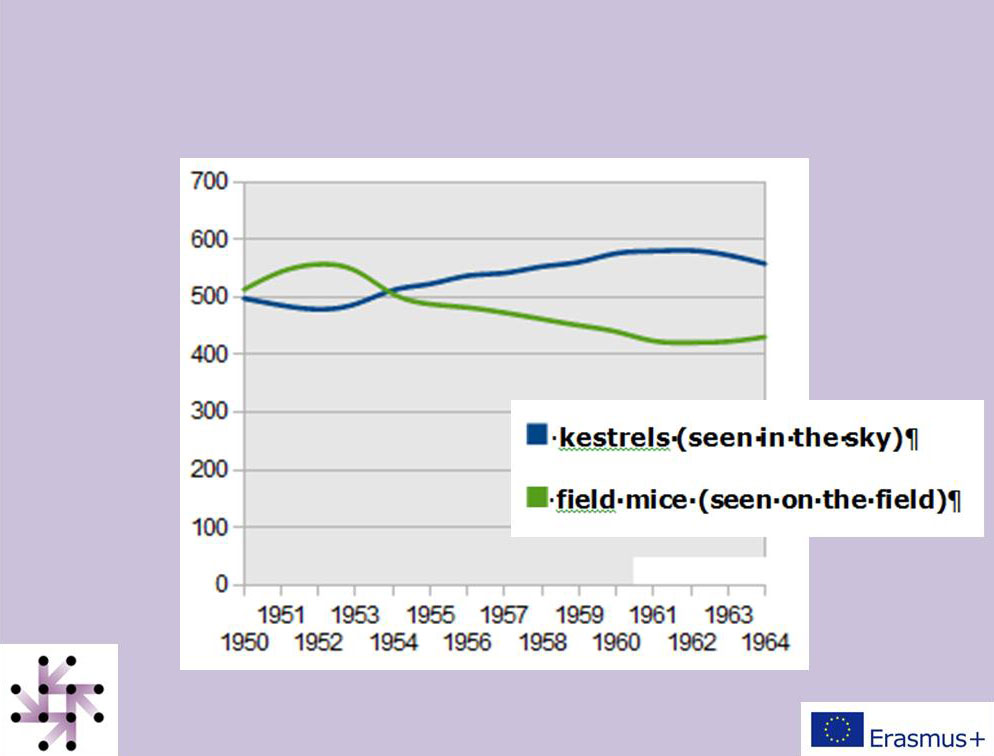
Allow´s try to interpret this example carefully.
Analysis i: Reading basics
Kickoff you take to read the labels and the legend of the
In our example…
- x-Centrality: You tin read what years the animals have been sighted.
- y-Axis: Yous can read the numbers of sightings.
- Blue line: The number of sighted kestrels.
- Light-green line: The number of sighted field mice.
And so this diagram visualises how many kestrels and field mice have been sighted over the years by Roy.
Assay two: Reading of import numbers
First we have to read the most of import points. Important points are peaks, lows, turning points and intersection points.
In our example…
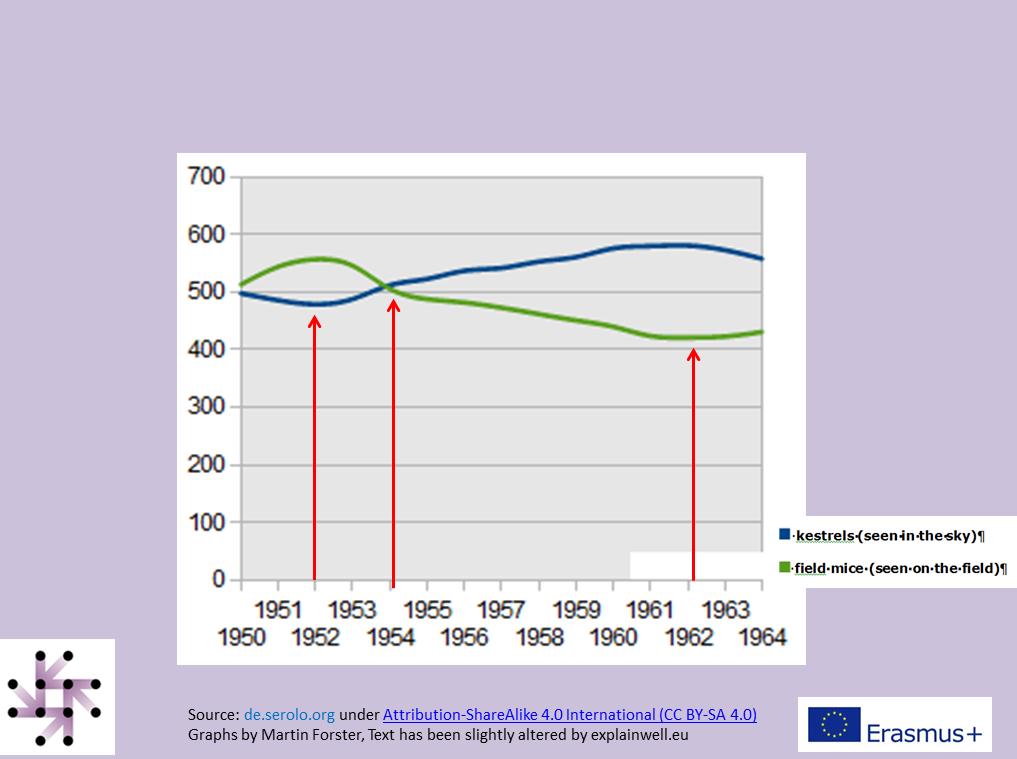
- 1952: A superlative of the mice line and a low of the kestrel's line. A turning point for both lines.
- 1954: An intersection point between the kestrel's line and mice line.
- 1962: A low signal of the mice line and a highpoint for the kestrel's line. A turning point for both lines.
Analysis 3: Define trends
Now information technology is important to define all significant trends.
In our example…
Sightings of kestrels:
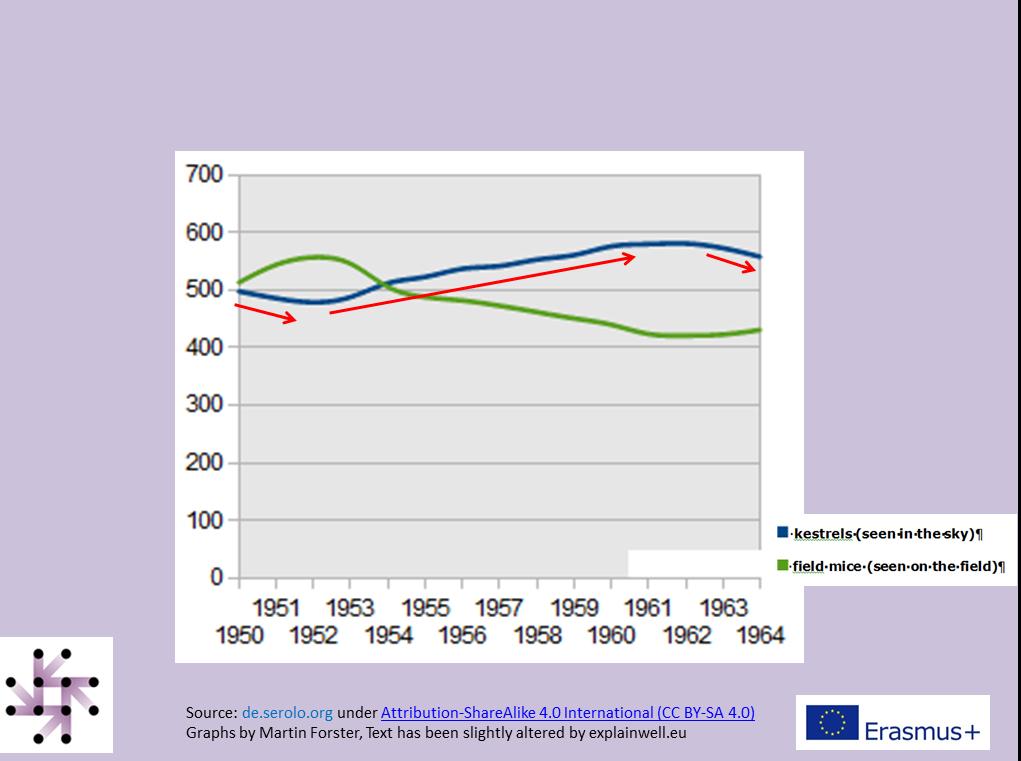
- From 1950 to 1952 they drop.
- Since 1952 they rise steadily.
- Since 1962 they drop slightly again.
Sightings of field mice:
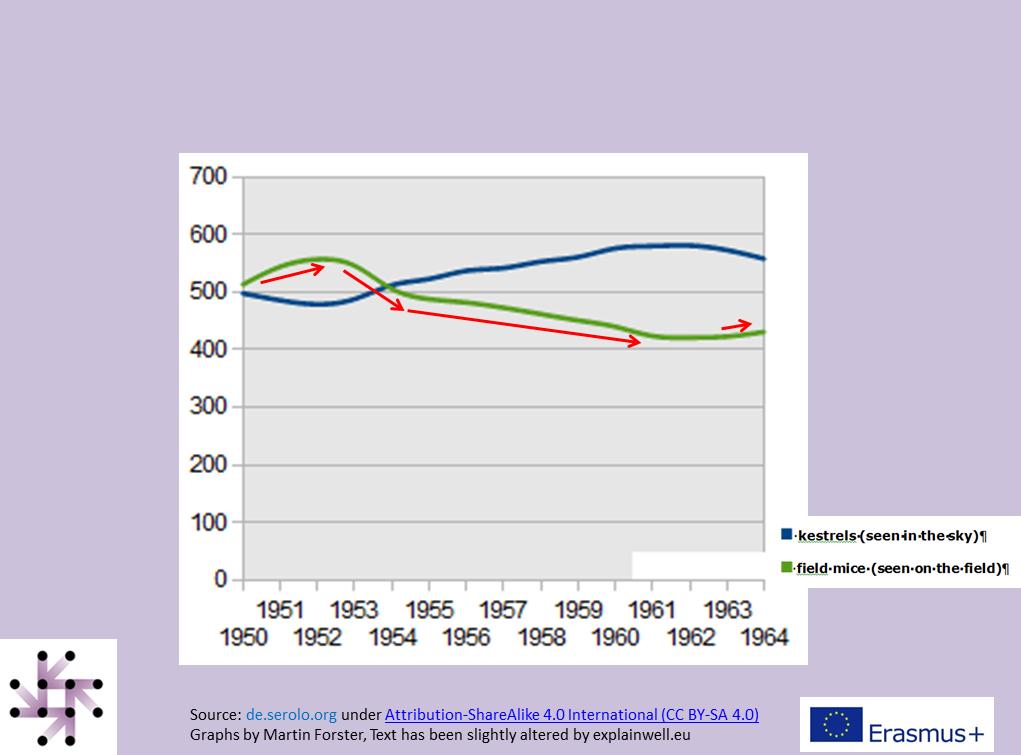
- From 1950 to 1952 they rise significantly.
- Since 1952 they drib significantly.
- Since 1954 they drib much slower.
- Since 1962 they rising again slowly.
Assay 4: Compare trends
Knowing the trends, we can compare them, to find out differences and relations.
Are at that place common trends?
Is in that location a pattern?
In our case…
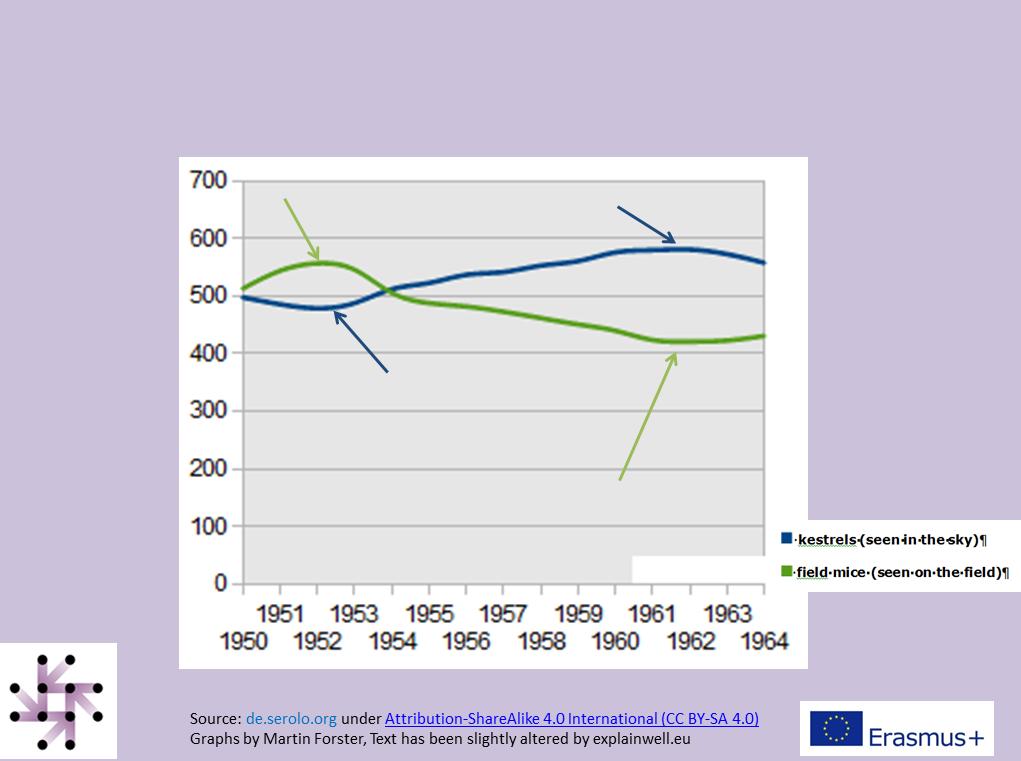
- When there are many sightings of field mice, there are fewer sightings of kestrels.
- When there are many sightings of kestrels, there are fewer sightings of field mice
Analysis 5: Analyse trends
Finally nosotros can plant hypotheses how the data is related. These hypotheses have to be questioned and assessed.
In our case…
A) "Mice swallow kestrels. Therefore there are many kestrels when there are less mice."
- According to our diagram this is possible. Merely: We know that mice do not eat kestrels.
B) "The kestrels hunt the mice. Therefore in that location can only be a lot of mice when there are fewer kestrels."
- Mice are typical food for kestrels. This hypothesis could exist correct.
C) "The Mice hide from the kestrels. When there are many kestrels to run into, we cannot meet many mice."
- Prey animals often shelter from their hunters. Too this hypothesis could be correct.
D) "The relation between sightings of kestrels and mice is simply a translucent connection. The numbers of sightings have very unlike reasons."
- Very oft there are only translucent connections. In that location tin can exist many reasons why Mr. Varney sights a certain number of animals each twelvemonth. Besides this hypothesis could exist correct.
Assay 6: Predict a development
Based on the development of the diagram and the established hypothesis we can predict future developments of the diagram.
But be conscientious: Predictions are always simply speculations!
In our example…

- Towards the end the lines become closer again. If they keep like that there will exist an intersection at some point.
- In the coming years at that place might be more than sightings of mice than kestrels.
Conclusion
A diagram helps to draft a hypothesis. To check a hypothesis very often you need to practise an experiment. Based on a diagram, graph or chart we can predict a development in the hereafter. But we accept to be aware that it is only a prediction.
This instance nigh kestrels and mice has been published past courtesy of de.serolo.org.
Concept and graphs by writer Martin Forster.
Notation: Some words in the graphs have been deleted to brand it suitable for international use. Arrows to explain graphs have been added.
Some text has been changed slightly to suit the audience of explainwell.european union.
Yous tin find the original nether: https://de.serlo.org/biologie/kompetenzen-in-der-biologie/diagramme/wie-wertet-man-ein-diagramm-aus
Serlos work is under Attribution-ShareAlike 4.0 International (CC BY-SA 4.0)

Source: http://explainwell.org/index.php/table-of-contents-handle-numbers/phrases-and-6-analysis-steps-to-interpret-a-graph/
0 Response to "Graph Description It Remain Elevated Then Well Supress and Rose Again"
Post a Comment